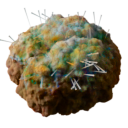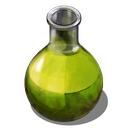Hello, last week you've seen how Gleba looks, it's time to get a glimpse of what you can do there.
With the idea of being a biological planet full of life, it seems reasonable to expect our engineer is about to harvest some of that.
We already have ways of harvesting nature, specifically trees. On Nauvis we either just hit them with an axe enough times, or later our construction robots take care of that friendly forest devastation.
These tools aren't quite up to speed to be a part of a mass-production chain in our factories, though...
Both of the Nauvis methods are initiated manually so not the best for automation, and the trees don't grow back - so once an area has been harvested, you need to move your operation further.
The Agricultural tower is a new machine unlocked on Gleba. It automatically harvests trees in its range.
There are two plants on Gleba which are specifically interesting as they can be not just harvested, but also re-planted by the tower. Today we'll have a look at one of them.
Agricultural tower harvesting and re-planting a tree. A lot of the things you see here are subject to change.
Harvesting a plant yields fruit, which can then be processed in an assembling machine into usable products - and seeds.
Fruit being processed in an assembling machine, resulting in seeds and mash.
Seeds can then be put back into the Agricultural tower to seed a new plant. The plant will grow over time, and when it matures the Agricultural tower will automatically harvest it.
Each new plant is seeded with a 3-tile gap from each other, resulting in a square pattern. This contributes to the entire process feeling artificial, like a plantation, rather than just wild nature.
The agricultural plants can only be seeded on very specific tiles, so you'll need to obey some environmental conditions. As you can probably guess though, this is Factorio, so we'll for sure let you wreck said environment with special landfill-like soils you'll be able to develop with just a bit of research.
Larger scale farming using artificial soil.
Every planet we have presented so far has a unique crafting structure, here on Gleba it is the Biochamber.
It is used to process all of the plant fruits into more industrial products like carbon fiber or a mysterious material we call Bioflux, but more on that later.
A tiny bit of Biochamber processing.
The quirk of the Biochamber is that it needs to be fed Nutrients to operate.
Unlike the Foundry and Electromagnetic plant, the Biochamber isn't really used for any Nauvis recipes, but it has its own set of recipes which basically replace oil processing on this planet.
All this time you're probably asking yourself (or already posting messages about it before reading further) what are the weird white lines in the images above.
Now we're getting into what makes Gleba really special - When fruit is harvested, or most other biological products are made, it will eventually spoil - which turns it into a new item we call Spoilage.

This process is inevitable and can't be delayed, however different items have different spoil times, ranging from about 2 hours to mere minutes. This means that there are ways to control the mechanic and optimize for getting a less spoiled product in the end.
Organic items eventually turn into Spoilage.
The reason why you're optimizing for a better product is because recipe results inherit their freshness from the ingredients. This means that when you craft a product out of a 30% spoiled ingredient, the product will also be 30% spoiled.
You can't serve a fresh salad from moldy lettuce either.
Effectively the spoilable items need to be perceived as temporary, and it's the throughput that matters, while in contrast buffering a stockpile isn't helpful at all.
When we were considering the idea of timed life for items, one of the first questions was whether they should just disappear or turn into something. If they just disappeared it would be more convenient as you wouldn't need to worry about the piles of spoilage you're inevitably going to accumulate, but you wouldn't know that something had spoiled as there would be no traces of it.
That's why spoilage exists, and we have multiple methods to get rid of it - you can burn it, waste it in a recycler, or create nutrients that are already half-spoilt.
Three examples of getting rid of spoilage.
To avoid this mechanic being over the top and to allow meaningful decisions to be made, there are some items where their freshness doesn't contribute to the final product as the final product is something that isn't spoilable. On the other hand, the new Agricultural science packs do spoil which reduces their value for research, so you will be incentivized to try to bring home the freshest science packs you can.

There are some items and recipes with spoilable ingredients which need to be crafted on different planets, so on top of optimizing the production chain, it'll also be meaningful to make a fast space platform to deliver them.
The main tools for manipulating spoilables are inserters, with a new ability to prioritize the freshest or the most spoiled items when picking up from inventories, and filtering out spoilage with splitters.
Over the time we've been developing the Gleba gameplay, it went through some drastic changes.
Initially we had about 10 plants which were harvested directly into items like plastic or sulfur, but it just became very broad but shallow, and tedious as a result. It is worth noting that it wasn't very interesting either, as that's basically how a mining drill works. Instead, we've reduced it to 2 plants to cultivate, and their fruits are processed into a much wider variety of items - also in much higher volumes - which restored the feeling of building a factory in the way we know and love.
The seeds are not only useful for new plants, but also for creating biochambers and the seedable soil tiles, so there's some decisions to be made where you invest them.
All in all, we are confident that the gameplay of Gleba is different enough to be interesting, yet builds on similar enough principles to feel familiar and well, actually be fun!
The visuals are still subject to change along with improvements to some effects. The graphics of the new machines you can see here come primarily from our usual suspects Earendel on concept art, with Jerzy taking care of the 3D pipeline. The agricultural tower has a very long telescopic arm, much longer than any other legs or arms, which resulted in being very technically demanding to make, both for Jerzy and for Lou breaking their brains with the drawing code. The biochamber was more straight forward but Jerzy had a field day with his crazy geometry nodes simulations.
There's a lot more details to be shared, but those will be easier to digest when you have the game in your hands, and/or in some later FFF.
As always, bring your half-spoiled fish to the market of opinions.